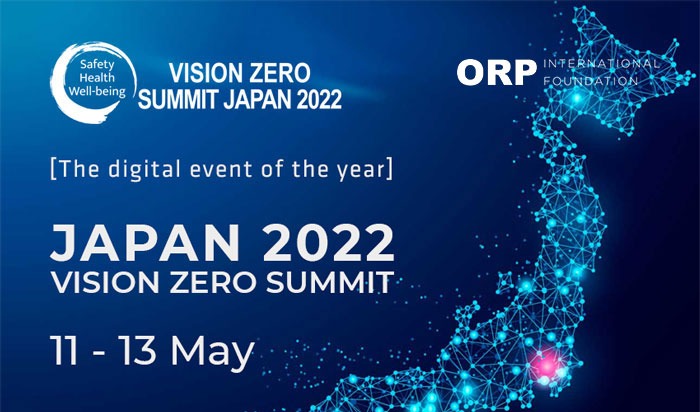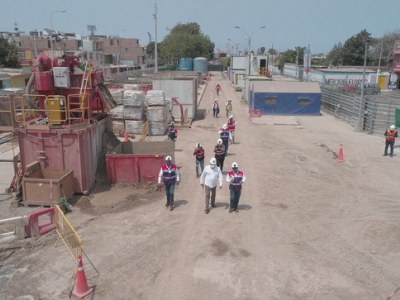The Vision Zero Summit Japan 2022
The Vision Zero Summit Japan 2022

INTRODUCTION TO SUMMIT SESSIONS
The Vision Zero Summit Japan 2022 consist of 16 exciting technical Sessions presenting innovative solutions to a wide range of topics critical to redefining safety, health and well-being for the New Normal. In the following Session Chairs will give you a short introduction to each of them.
THE 1ST DAY
Hans-Horst Konkolewsky
Denmark
INTERNATIONAL ORP FOUNDATION (FIORP) PRESIDENT
Implementation of Vision Zero in Enterprises: From Vision to Reality
Health and sustainability have become top priories for businesses across the globe, as their overwhelming interest in joining the ISSA’s Vision Zero campaign clearly demonstrates. Safety, health and wellbeing are increasingly becoming an integrated part of the organizational culture as businesses recognize that their success depends more than ever on people. During the session senior OSH managers will share valuable insights and practical experiences from the Vision Zero journey of their companies. Special focus will be given the critical role of the leadership and the empowerment and active involvement of all employees in developing a prevention culture based on Vision Zero. The session will also explore how the Vision Zero mind-set can be promoted and developed in all business activities and at all locations of a company, and how it can be cascaded to all business partners, including supplier (sub)contractors and where relevant customers. Finally, as the world of work is changing dramatically due to the emerging digital economy, the related risks and opportunities for safety, health and wellbeing at work and thus for implementing Vision Zero will be discussed, and practical solutions be presented.
Ockert Dupper
South Africa
INTERNATIONAL LABOUR ORGANIZATION (ILO) VZF GLOBAL PROGRAMME MANAGER
Making global supply chains safer
Each morning, somewhere in the world, 1,000 people leave home for work and don’t come back, and another 6500 people die daily from diseases contracted as a result of an exposure to risk factors arising from work activity. These are the people who make our clothes. Grow the beans for our coffee. Construct the buildings in which we live and work. They need safe, healthy workplaces, and deserve our shared commitment to improving health and safety up and down the global supply chain. The G-7-mandated and ILO-administered Vision Zero Fund (VZF) mobilize governments, employers, workers and other stakeholders to make real, measurable improvements in worker health and safety where they are most needed. Working at all levels of the supply chain, from factories and fields to governments and global enterprises, the VZF strategically target sectors and regions where it believes it can make a positive difference.
This session will be divided into two parts. Part I will discuss what global buyers can do to improve safety and health along global supply chains, especially when operating in countries with weak or deficient national safety and health and employment injury protection schemes. Part II is dedicated to a discussion of Vision Zero Fund’s efforts to make global supply chains safer. It will highlight good practices and achievements, but also identify endemic challenges that will require the collective action of all stakeholders, including multinational enterprises and OSH practitioners, to address.
Tamio Tanikawa
Japan
NATIONAL INSTITUTE OF ADVANCED INDUSTRIAL SCIENCE AND TECHNOLOGY (AIST) DEPUTY DIRECTOR, RESEARCH CENTER TEAM LEADER
Mobility/Auto-mobile/Auto-Guided-Vehicle (AGV)
With the advancement of AI technology, the expectation of automated driving has been increasing. Human recognition technology is not only being used for automated driving in automobiles, but also for AGVs in factories as well. As a result, the use of autonomous mobile robots is expected to advance in a variety of fields. In this session, we will have an introduction to the technologies and applications for moving mobile robots more safely in spaces where people coexist, including automated driving, and confirm the direction of necessary safety technologies.
Takashi Kawata
Japan
SHIMIZU CORPORATION ADVISOR
Construction Industry: Improvement of OSH and Productivity
It is very important thing that to increase productivity and provide our clients with low-cost, high-quality constructions in corporations. But it’s needed to enormous effort to build a structure at a low cost, or keeping swift pace, while ensuring safety. What this means is that we have to ensure both safety and productivity as we can’t afford to cause our clients inconvenience, such as delays in construction schedules due to ensure safety. That’s why we in the construction industry are implementing initiatives to make Safety Improvement and Improvement productivity coexist. In short, we would like to discuss the coexistence of Improvement productivity and Safety Improvement in the corporations in this session. We would also like to set a slogan as a goal for the session. Finally, through these discussions, we aim to promote awareness that contributes to the promotion of the SDGs and to the realization of well-being.
Rene Leblanc
Canada
INTERNATIONAL OCCUPATIONAL HYGIENE ASSOCIATION (IOHA) IOHA PAST-PRESIDENT 2020
Health/Hygiene/COVID19
The World is facing the worst pandemic for over a Century with the Coronavirus SARS-CoV-2. Many countries faced the pandemic with different approaches as something this importance has never been experienced before. We will discuss and learned from the best practices, and less good experiences, that was implemented in different countries. Before this pandemic, ILO had estimated that approximately 2,8 millions workers were already dying from their work, mostly from non-communicable disease (asbestosis, silicosis, lung cancer, etc.) The experience and lessons learned from Covid-19 must be applied to continue protecting general population and workers from hazards, We will finally discuss in this session about how we can better protect workers and population’s health from their work, life habits, their cultural legacy and their environment.
THE 2ND DAY
Alan Stevens
United Kingdom
INSTITUTION OF OCCUPATIONAL SAFETY AND HEALTH (IOSH) HEAD OF STRATEGIC ENGAGEMENT
Future business leaders: achieving healthier performance and productivity
Global trends are shaping a new world of work, with changes in workplace demographics, technology and working practices, as well as responses to the Covid-19 pandemic, putting increasing pressure on businesses to operate sustainably and responsibly. As a consequence, managers and leaders must now focus not only on what results are delivered, but how those results are obtained. At the heart of this is good OSH practice and this should be part of every manager’s and leader’s accountability. Without exception, good sustainable businesses invest in the safety and the physical and mental health and wellbeing of their people. They plan and pursue their objectives in ways that prevent harm and provide benefits. Managers and leaders must progress beyond simple regulatory compliance to understand instead how the wellbeing of their staff can deliver reputational and competitive advantages. They must look outward and care about the communities in which they operate. They need to work to mitigate their impacts on the environment and society, and they consider the principle of social good in all that they do. Businesses like these seek leaders and managers who are constantly proactive in finding ways to grow and improve. They seek leaders and managers who look to the long term and actively plan for change. The leaders and managers they attract will build resilient organizations which gain enviable reputations and win more business. These entities will find it easier to recruit and retain great people, to make better client relationships and they are championed by their local community. In summary, good businesses are more successful when placing OSH at the heart of their management and leadership frameworks. This panel session discusses the core competencies required to deliver excellent OSH performance in work settings, and it showcases examples of how outstanding OSH leadership and management practices have been driven throughout their corporate DNA
Bernd Treichel
Switzerland
INTERNATIONAL SOCIAL SECURITY ASSOCIATION (ISSA) SENIOR TECHNICAL SPECIALIST IN PREVENTION AND SOCIAL SECURITY
Vision Zero Proactive Leading Indicators
The Proactive Leading Indicators are offered by the International Social Security Association (ISSA) as a free supplementary tool for every enterprise and organization committed to VISION ZERO, be they advanced or beginner, large or small, local or international. The Proactive Leading Indicators can be used for multiple purposes: improving safety, health and wellbeing, working towards external business relations and supply chains, or for benchmarking purposes. They were developed by sourcing information and evidence from leading VISION ZERO organizations, scientific literature, publications from other reputable sources (e.g. national agencies, industry), and the expertise and experience available in the project team and steering committee. The session will showcase the science behind the indicators, offer practical solutions and provide application examples and results achieved by companies.
Rieko Hojo
Japan
NATIONAL INSTITUTE OF OCCUPATIONAL SAFETY AND HEALTH, JAPAN (JNIOSH) SENIOR RESEARCHER, ASSOCIATE PROFESSOR
Think of Human Factors -Toward the realization of a safe, secure and well-being society
In this Session, human factors about safety, health and happiness will be discussed. In addition, not only these three factors but also well-being at work would be the topic of this session. In this session six authorities of Human Factors would give talks.
A principle of human behavior from a research field called [Behavior analysis] and some examples of experiment using the principle would be introduced. Also, specialists of Human Factors at National Institutes of France and Finland will introduce research outcomes, such as technologies in the transport and logistics sector, and human-focused work practices in nuclear maintenance operations from human side. Then, a chief consultant from venerable Danish consultant company in working environment and management will introduce Proactive Leader Indicator (PLI) leading to worker well-being. In addition, a researcher having background in human geography and cultural anthropology, will show results from explored the fields of social housing relocation projects, peri-urban disaster management, water governance and volumetric urbanism. Our common focus and goal are better, safer, happier lives and higher well-beings of human at work. In the future, it will be necessary not only to prevent accidents and ensure safety, but also to change social systems to directions toward happiness and welfare through a positive cycle such as rewards not punishment. For that reason, research on human factors will become important in the future.
Yoshihiro Nakabo
Japan
NATIONAL INSTITUTE OF ADVANCED INDUSTRIAL SCIENCE AND TECHNOLOGY (AIST) SENIOR RESEARCHER
Robotics/Collaborative safety
Recent advances in IoT devices have made it possible for people and machines to work together or co-operate safely. We will collect reports and discuss issues related to safety technologies, practices, and standardization when humans and robots, or various machines share time and space to operate in a variety of work environments, not only in manufacturing, but also in various other work environments.
Shoken Shimizu
Japan
NATIONAL INSTITUTE OF OCCUPATIONAL SAFETY AND HEALTH, JAPAN (JNIOSH) SUPERVISING RESEARCHER
Safety, Health and Well-being Activities in Manufacturing Sites
This session will introduce examples of Vision Zero activities and health and safety activities (Zero Accident Movement) in workplaces in various countries, aiming to reduce occupational accidents, occupational diseases and risk factors in manufacturing sites to zero.
Vision Zero is a global campaign involving companies and organizations that share the belief that all disasters, illnesses, and injuries are preventable, and the fundamental values of safety, health, and happiness. Currently, 11,000 companies and organizations are participating in this campaign, and the number is increasing every year.
Through this session, we aim to build an international network to achieve zero occupational accidents.
Sadao Takeda
Japan
INSTITUTE OF GLOBAL SAFETY PROMOTION (IGSAP) DIRECTOR
Well-being and SDGs
“Well-being” is newly introduced for Occupational Safety & Health activities by Vision Zero. Recently, organizations which consider the “Well-being” as one of the key management targets, have been increasing. Vision Zero supports such trend. It also brings the sustainability of business development as well as people’s decent working life, thus contributes to the achievement of SDGs. The SDGs have become an indispensable aspect for business and society now and in the future.
In this session, the following subjects will be discussed by world opinion leaders from academia and business.
(1) Concept and role of well-being
(2) Well-being and organizational approaches in corporate management
(3) Environmental changes and the growing importance of well-being in OSH
(4) Well-being, Innovation and International Standardization
(5) How to understand SDGs, SDGs /ESG management by organizations
THE 3RD DAY
Dr. Tommi Alanko
Finland
FINNISH INSTITUTE OF OCCUPATIONAL HEALTH (FIOH) DIRECTOR OF OCCUPATIONAL SAFETY UNIT
Building OSH capacity through Higher Education, Online Learning, and Credentialing
Vision Zero aims to promote safety, health, and well-being globally. Learning is a key element to realize Vision Zero in practice. The session focuses on diverse aspects of building OSH capacity by presenting campaigns, training programs and projects which aim to raise OSH awareness and provide tools to strengthen OSH expertise. The session also reflects existing and future challenges as well as opportunities for OSH training. What are effective and meaningful ways to learn and train OSH in educational and work context? What works and why? The session provides a forum for sharing experiences and introducing innovative means and methods of traditional and digital training. Presentations cover e.g. design and implementation of e-learning and virtual reality training.
Toshiyuki Kajiya
Japan
INTERNATIONAL ELECTROTECHNICAL COMMISSION (IEC) VICE-CHAIR OF IECEE CERTIFICATION MANAGEMENT COMMITTEE OF IEC
International standardization for Safety, Health and Wellbeing
In the time where ICT, AI, and robotics are developing rapidly, new technologies are enabling the new way of OSH that was not possible before. How the OSH in future will and should look like has been described in the IEC MSB white paper “Safety in the Future” (published in November 2020), and ISO is also working on how robots, which work with humans, should operate while keeping workers’ safety. This session will look at how technologies should develop in tandem with international standards, such as in the aspect of conformity assessment.
Yoshiki Seo
Japan
NATIONAL INSTITUTE OF ADVANCED INDUSTRIAL SCIENCE AND TECHNOLOGY (AIST) DIRECTOR, INFORMATION STANDARDIZATION OFFICE
AI/ICT & digitalization
Artificial intelligence is thought to be the key game changer for almost all of businesses in the near future. However, nobody knows how to manage solutions including AI components, and quality management technologies for AI software is still very premature. In this session, difficulty to manage AI quality and how we can overcome the problem is to be discussed. We will put special focus on the relationship between AI quality management and the Vision Zero concept (i.e AI embedded robots working together with human).
Magdalena Wachnicka-Witzke
Poland
AGRICULTURAL SOCIAL INSURANCE FUND (KRUS) DIRECTOR OF THE COMMUNICATION AND INTERNATIONAL COOPERATION OFFICE
Agriculture and OSH Agri (OSH) Culture
Agriculture as a sector of economy has one of the highest records of fatal accidents and injuries at work. The Vision Zero concept with its three dimensions of occupational prevention: safety, health and wellbeing proposes how to structure a prevention system to build a successful OSH culture in Agriculture – AGRI (OSH) CULTURE. People working in agriculture face many different types of occupational hazards and are exposed to many various types of occupational risks. This makes the building of AGRI OSH Culture so important but at the same time very challenging. In this session, we shall present current occupational hazards that farmers face during their work and possible solutions how to prevent them to keep safety, health and wellbeing of farmers. The session will be organized in three following subtopics:
Environmental hazards and challenges
Use of modern technologies and artificial intelligence.
Unbearable burden of stress – mental health and wellbeing
Dr. Mohammed Azman Aziz Mohammed
Malaysia
SOCIAL SECURITY ORGANIZATION OF MALAYSIA CEO / DIRECTOR GENERAL
National Strategy to promote Vision Zero
“The Vision Zero mindset that all accidents, diseases and harm at work can be prevented, has been shared by a large and still growing number of companies and partner organizations, including governments and social security institutions. Their active role in promoting Vision Zero at national level is of critical importance for achieving the objective of the global campaign, to support the development of a prevention culture based on the Vision Zero mindset.
During this session senior representatives from ministries, worker’s compensation systems and other social security organizations will present their Vision Zero strategies and programs and share valuable experiences related to the successful promotion of Vision Zero in their countries. Reflecting the diverse national contexts, different formats have been developed, ranging from a focus on Zero Accidents or integrating Vision Zero as part of a wider prevention campaign, to developing a new national prevention strategy dedicated to promoting Vision Zero.”








